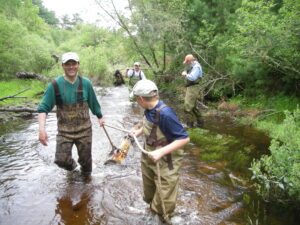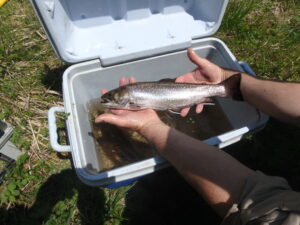You probably never heard of Red Brook. Well, it’s a small spring fed, 4.5-mile brook that serves as the boundary between Plymouth and Wareham in southeastern Massachusetts. It empties into Buttermilk Bay near the Cape Cod Canal. Its claim to fame is that it is among just a few streams south of Maine to hold a viable population of so-called “salters.” (brook trout that move back and forth between fresh and saltwater).
A little history: Having been lured to Red Brook by its sea-run brook trout fishery, Theodore Lyman III began buying land along its banks in 1870. His first purchase was a small house, salt marsh and shoreline on Buttermilk Bay. Over the years, adjacent pieces of property were acquired and the total amount of land became substantial and difficult for the family to properly manage.
The Lyman family eventually deeded over their Red Brook property to the MA Council of Trout Unlimited, with the understanding that TU would restore the brook’s sea-run brook trout fishery. At the time, there were approximately 5,000 members in Massachusetts and Rhode Island, with a dozen or so chapters. They are volunteers dedicated to the enhancement and preservation of cold waters and their fisheries, not to acquire land. Now it was tasked with the responsibility of preserving some 650 acres through which the stream flows. It was a daunting task trying to raise funds in order to manage it.
In 2001 TU National signed an agreement with The Trustees of Reservations (TTOR) and the Massachusetts Division of Fisheries and Wildlife (DFW) that created the 638-acre Red Brook Reserve. The 210-acre Lyman Reserve, owned by the TTOR, is jointly managed by the three parties. The 428-acre Red Brook Wildlife Management Unit section of the reserve was expanded in 2009 to protect the entire stream by the purchase of 245 acres at its headwaters.
Between 2006 and 2009, four dams were removed from Red Brook in the Lyman Reserve by the Massachusetts Division of Ecological Restoration, TU and TTOR, along with extensive habitat restoration. TU and its partners have invested millions of dollars and tens of thousands of hours to help protect those salter brook trout and because of that Red Brook’s brook trout population is healthy once again. Herring, eels and brook trout now swim an unobstructed Red Brook for the first time in 150 years. A restoration of Red Brook in cranberry bogs at the headwaters began.
All that effort was put at risk recently by a proposed change to zoning on a large parcel in the stream’s headwaters, which then allowed only single-family homes on lots of three acres. The change was to create a “hospitality, recreation and entertainment” overlay district on 756 acres of pine barren land. If approved, it could have led to development of hotels, multi-family homes and possibly even a horse track and casino.
The proposal elicited fierce opposition from TU members and supporters, among many others.
A town vote was scheduled for April 10, 2022 in Wareham and as the vote approached, volunteers from TU chapters and the MA Council rapidly initiated a campaign to advocate for the defeat of the proposal. Donors helped raise over $15,000, which helped with advertising to urge citizens of the town to vote against the proposal. (Our local Taconic Chapter of TU kicked in $500).
Jeff Yates, TU National’s Director of Volunteer Operations did a terrific job of designing placards and yard signs and creating catchy slogans, such as, “Save the Salters!”
Other organizations opposed to the proposed zoning change included the Wareham Land Trust, the Southeastern Massachusetts Pine Barrens Alliance, the Buzzards Bay Coalition, TTOR, the Community Land and Water Coalition, the Sea Run Brook Trout Coalition, Wildlands Trust and the Northeast Wilderness Trust. The Herring Pond Wampanoag Tribe has also opposed the measure.
“Big box developments such as the one proposed in the headwaters are as common as bird poop on a summer windshield,” TU President and CEO Chris Wood wrote in a column prior to the vote. “The people of Wareham can send a powerful message to communities across New England by voting ‘no’ on April 10 and demonstrating that we are not a desperate nation willing to fill in every open space with concrete, glass and metal.”
And that’s what the voters did with an overwhelming “no” vote. “The rout was welcome to all who so quickly mobilized to ensure the protection of one of Massachusetts’ natural treasures and will, we can hope, show the power of a community coming together to fight for something it loves”, wrote the Wareham Week newspaper.
Because of its efforts, Peter Shilling, former Massachusetts Council Chairman and current delegate nominated it as the Council of the Year as a part of TU’s Annual Awards, and it was selected.
“Congratulations” wrote Beverly Smith, VP for Volunteer Operations. “The work you all have put in has shown clear results in the rivers and communities you support. The opening of Peter’s nomination says it all:
“Successful organizations like the Massachusetts Council have a fabric, a tapestry woven and held together over time by the relationships of people bound by common beliefs and goals. The quality of those connections, what people pass along person to person over time, is what leads to success in accomplishing significant goals, conservation or otherwise. The nomination of this award for the Massachusetts Council comes out of its work last year saving Red Brook, a fully restored sea run brook trout stream, from devastating development in its headwaters. But the story really is longer, broader and deeper than just one year’s actions, however significant.”
“We can’t say it better than that” wrote Smith.
The Massachusetts Councill will be honored in front of TU volunteer peers from across the nation at TU’s Annual Award celebration on Friday, July 22 in Portland, Maine. Most likely current MA Council President Henry Sweren, from Lanesborough, will be there to accept the award on behalf of the Council.
“It’ll be a real treat to honor and celebrate you!” wrote Smith. “On behalf of all of us at TU, a big thank you and congratulations!”
I should mention that although the Massachusetts Council and its statewide chapters steadfastly supported the Red Brook project over the past 30 years, the brunt of the workload (manual labor, fundraising, etc.) was carried out by members of the Cape Cod and Southeast Chapters of TU with serious funding by the Greater Boston Chapter. There have been many wonderful volunteers fighting to preserve that little brook over those years, especially Cape Cod TU member and Council delegate Warren Winders. He deserves an extra pat on the back for his unwavering and steadfast efforts.
But wait, there’s more. Don’t be surprised if the Massachusetts Council, and particularly the Deerfield River Watershed Chapter of TU, receive another award in the future for work they are doing on the Deerfield River. DRWTU members Kevin Parsons, Chris Jackson and others are receiving national attention for their brown trout studies and their efforts in working with various state and federal agencies and Brookfield Power Co. in trying to level off the year-round water flows which to date have been so harmful to the reproduction of the wild brown trout population.
The current FERC (Federal Energy Regulatory Commission) license allows for minimum flows of 125 cfs (cubic feet per second) year-round. For the new license, DRWTU, MA DEP and MA DFW have been pushing to increase the minimum flow to 225 cfs from November to April to protect wild brown trout redds and eggs from being de-watered and exposed to the air, killing them off.
Two past brown trout spawning studies showed that nearly 40 percent of identified trout redds were de-watered at flows of 125 cfs. Further studies showed that at 225 cfs, the redds, flowing water would cover the eggs and keep them protected. Parsons and Jackson have been doggedly pursuing this goal for many years and there may be a breakthrough this year.
Incidentally, Trout Unlimited has approximately 300,000 members nationwide with about 390 chapters. The chapter in the Berkshires is the Taconic Chapter. Most states have a TU Council with delegates from all chapters.
On a personal note, I have been a card-carrying member of the Taconic Chapter for nearly 40 years now and as I wrote in last week’s column, “Stuff like this (above) is what makes me proud to be a member of such great organizations”.

